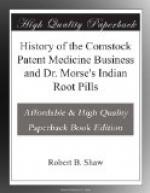The Indian Root Pill business was carried on during most of its existence by two members of the Comstock family—father and son—and because of unusual longevity, this control by two generations extended for over a century. The plant was also located in Morristown for approximately ninety years. The Indian Root Pills, however, were not actually originated by the Comstock family, nor were they discovered in Morristown. Rather, the business had its genesis in New York City, at a time when the city still consisted primarily of two-or three-story buildings and did not extend beyond the present 42nd Street.
According to an affidavit written in 1851—and much of the history of the business is derived from documents prepared in connection with numerous lawsuits—the founder of the Comstock drug venture was Edwin Comstock, sometime in or before 1833. Edwin, along with the numerous other brothers who will shortly enter the picture, was a son of Samuel Comstock, of Butternuts, Otsego County, New York. Samuel, a fifth-generation descendant of William Comstock, one of the pioneer settlers of New London, Connecticut, and ancestor of most of the Comstocks in America, was born in East Lyme, Connecticut, a few years before the Revolution, but sometime after the birth of Edwin in 1794 he moved to Otsego County, New York.
Edwin, in 1828, moved to Batavia, New York, where his son, William Henry Comstock, was born on August 1, 1830. Within four or five years, however, Edwin repaired to New York City, where he established the extensive drug and medicine business that was to be carried on by members of his family for over a century. Just why Edwin performed this brief sojourn in Batavia, or where he made his initial entry into the drug trade, is not clear, although the rapid growth of his firm in New York City suggests that he had had previous experience in that field. It is a plausible surmise that he may have worked in Batavia in the drug store of Dr. Levant B. Cotes, which was destroyed in the village-wide fire of April 19, 1833; the termination of Edwin’s career in Batavia might have been associated either with that disaster or with the death of his wife in 1831.
The Comstocks also obviously had some medical tradition in their family. Samuel’s younger brother, John Lee Comstock, was trained as a physician and served in that capacity during the War of 1812—although he was to gain greater prominence as a historian and natural philosopher. All five of Samuel’s sons participated at least briefly in the drug trade, while two of them also had careers as medical doctors. A cousin of Edwin, Thomas Griswold Comstock (born 1829), also became a prominent homeopathic physician and gynecologist in St. Louis.[1] It might also be significant that the original home of the Comstock family, in Connecticut, was within a few miles of the scene of the discovery of the first patent medicine in America—Lee’s “Bilious Pills”—by Dr. Samuel Lee (1744-1805), of Windham, sometime prior to 1796.[2] This medicine enjoyed such a rapid success that it was soon being widely imitated, and the Comstocks could not have been unaware of its popularity.




